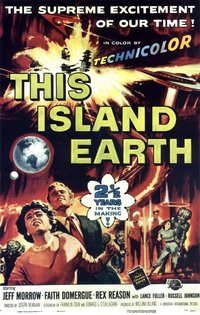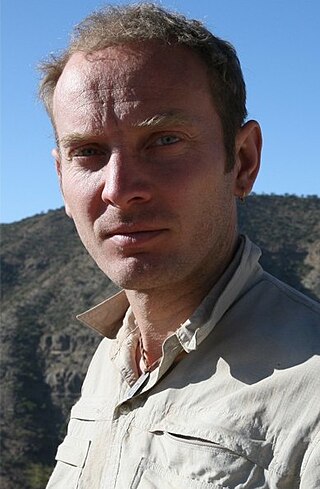
Granite is a coarse-grained (phaneritic) intrusive igneous rock composed mostly of quartz, alkali feldspar, and plagioclase. It forms from magma with a high content of silica and alkali metal oxides that slowly cools and solidifies underground. It is common in the continental crust of Earth, where it is found in igneous intrusions. These range in size from dikes only a few centimeters across to batholiths exposed over hundreds of square kilometers.

Structural geology is the study of the three-dimensional distribution of rock units with respect to their deformational histories. The primary goal of structural geology is to use measurements of present-day rock geometries to uncover information about the history of deformation (strain) in the rocks, and ultimately, to understand the stress field that resulted in the observed strain and geometries. This understanding of the dynamics of the stress field can be linked to important events in the geologic past; a common goal is to understand the structural evolution of a particular area with respect to regionally widespread patterns of rock deformation due to plate tectonics.

Magma is the molten or semi-molten natural material from which all igneous rocks are formed. Magma is found beneath the surface of the Earth, and evidence of magmatism has also been discovered on other terrestrial planets and some natural satellites. Besides molten rock, magma may also contain suspended crystals and gas bubbles.

In geology, rock is any naturally occurring solid mass or aggregate of minerals or mineraloid matter. It is categorized by the minerals included, its chemical composition, and the way in which it is formed. Rocks form the Earth's outer solid layer, the crust, and most of its interior, except for the liquid outer core and pockets of magma in the asthenosphere. The study of rocks involves multiple subdisciplines of geology, including petrology and mineralogy. It may be limited to rocks found on Earth, or it may include planetary geology that studies the rocks of other celestial objects.

The Core is a 2003 American science fiction disaster film directed by Jon Amiel and starring Aaron Eckhart, Hilary Swank, Delroy Lindo, Stanley Tucci, D. J. Qualls, Richard Jenkins, Tcheky Karyo, Bruce Greenwood, and Alfre Woodard.

Project Plowshare was the overall United States program for the development of techniques to use nuclear explosives for peaceful construction purposes. The program was organized in June 1957 as part of the worldwide Atoms for Peace efforts. As part of the program, 35 nuclear warheads were detonated in 27 separate tests. A similar program was carried out in the Soviet Union under the name Nuclear Explosions for the National Economy.
Hydrothermal circulation in its most general sense is the circulation of hot water. Hydrothermal circulation occurs most often in the vicinity of sources of heat within the Earth's crust. In general, this occurs near volcanic activity, but can occur in the shallow to mid crust along deeply penetrating fault irregularities or in the deep crust related to the intrusion of granite, or as the result of orogeny or metamorphism. Hydrothermal circulation often results in hydrothermal mineral deposits.

X the Unknown is a 1956 British science fiction horror film directed by Leslie Norman and starring Dean Jagger and Edward Chapman. It was made by the Hammer Film Productions company and written by Jimmy Sangster. The film is significant in that "it firmly established Hammer's transition from B-movie thrillers to out-and-out horror/science fiction" and, with The Quatermass Xperiment (1955) and Quatermass 2 (1957), completes "an important trilogy containing relevant allegorical threads revealing Cold War anxieties and a diminishing national identity resulting from Britain's decrease in status as a world power".

This Island Earth is a 1955 American science fiction film produced by William Alland, directed by Joseph M. Newman and Jack Arnold, and starring Jeff Morrow, Faith Domergue and Rex Reason. It is based on the 1952 novel of the same name by Raymond F. Jones. The film, distributed by Universal-International, was released in 1955 on a double feature with Abbott and Costello Meet the Mummy.

Earth's mantle is a layer of silicate rock between the crust and the outer core. It has a mass of 4.01×1024 kg (8.84×1024 lb) and thus makes up 67% of the mass of Earth. It has a thickness of 2,900 kilometers (1,800 mi) making up about 46% of Earth's radius and 84% of Earth's volume. It is predominantly solid but, on geologic time scales, it behaves as a viscous fluid, sometimes described as having the consistency of caramel. Partial melting of the mantle at mid-ocean ridges produces oceanic crust, and partial melting of the mantle at subduction zones produces continental crust.

Geothermal gradient is the rate of change in temperature with respect to increasing depth in Earth's interior. As a general rule, the crust temperature rises with depth due to the heat flow from the much hotter mantle; away from tectonic plate boundaries, temperature rises in about 25–30 inverse or negative geothermal gradient. The effects of weather, the Sun, and season only reach a depth of roughly 10–20 m (33–66 ft).

At the Earth's Core is a 1976 British-American fantasy-science fiction film produced by Britain's Amicus Productions.

Prediction of volcanic activity, or volcanic eruption forecasting, is an interdisciplinary monitoring and research effort to predict the time and severity of a volcano's eruption. Of particular importance is the prediction of hazardous eruptions that could lead to catastrophic loss of life, property, and disruption of human activities.

Catherine Hickson is a Canadian volcanologist, formerly with the Geological Survey of Canada, part of Natural Resources Canada. Since 2014, she has been the chief operating officer for Dajin Resources Corp. and president, Tuya Terra Geo Corp. Hickson studied at the University of British Columbia and received her PhD in geology and volcanology in 1987.
The following outline is provided as an overview of and topical guide to geology:

Dougal Alexander Jerram is a British geologist/earth scientist, and television and media presenter/contributor.
A continental arc is a type of volcanic arc occurring as an "arc-shape" topographic high region along a continental margin. The continental arc is formed at an active continental margin where two tectonic plates meet, and where one plate has continental crust and the other oceanic crust along the line of plate convergence, and a subduction zone develops. The magmatism and petrogenesis of continental crust are complicated: in essence, continental arcs reflect a mixture of oceanic crust materials, mantle wedge and continental crust materials.

The Cosmic Man is a 1959 independently made black-and-white science fiction film, directed by Herbert S. Greene and produced by Robert A. Terry. The film stars John Carradine, Bruce Bennett and Angela Greene. The narrative concerns an extraterrestrial being who, just as the space age is beginning, comes to Earth bearing a message of interplanetary peace and understanding, only to clash with the military. The Cosmic Man was made by Futura Productions Inc. and was distributed in the US by Allied Artists and in the UK by Associated British-Pathé.
Susan Marian Ellis is a geophysicist based in New Zealand, who specialises in modelling the geodynamics of the Earth's crust deformation, at different scales. Ellis is a principal scientist at GNS Science and her main interests are in subduction, seismology, tectonics, crust and petrology. Ellis's current work focuses on the influence of faulting on stresses in the crust, and how this is related to geological hazard and the tectonic settings in New Zealand.














